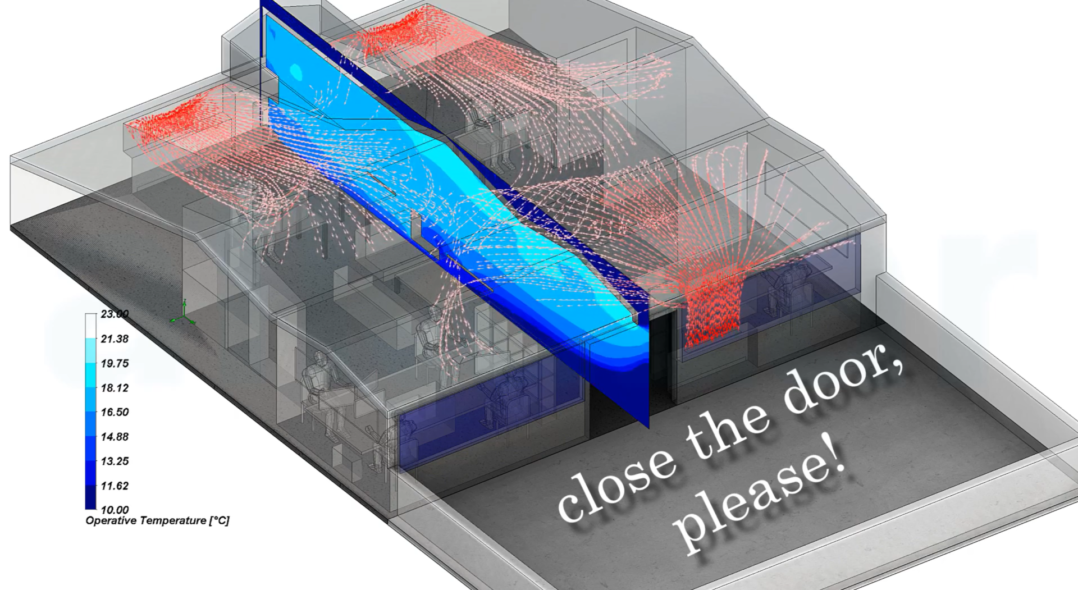
It is cold, please close the door!
Comfort level is an important criterion in the office environment where we spend most of our hours. The concept of comfort depends on many conditions such as thermal comfort, ventilation, natural daylight, adequate and correctly placed artificial lighting. In this blog post, we’ll talk about thermal comfort through our office and a little bit of indoor air quality.
Alkazar central office is in Istanbul. Our office is located in the attic and we have a terrace in front of the room. The connection between the office and the terrace is separated by a PVC sliding door. We preferred a day when the outdoor air is 4°C and 7 people work at the same time in the office. Office is air-conditioned with fan coil devices. The room temperature is measured as 21°C after a while after devices are operating.
Heaters are elements that contain a fan and a serpentine as a heat transfer surface. The hot water heated by the boiler is passed through the serpentines. The air taken from the room with the help of the fan is passed over the serpentines and blown back into the room. Thus, the air in the room is conditioned

The CO2 ratio is the parameter we may use most to measure indoor air quality. The CO2 emitted from the human mouth accumulates in the room after a while, increasing the rate of polluted air. We mentioned in our previous blog post that the risk increases in dead zones where adequate ventilation is not provided (https://alkazar.com.tr/blog/covid-19-positive-guest-in-open-office-pauze/). CO2 measured between 2000ppm – 5000ppm in the room causes headaches, low concentration, heart palpitations and insomnia. Continuous ventilation of the place by natural or mechanical means is important for health.

According to ASHRAE 55 and ISO 7730 standards, the temperature difference between the feet and the head of a sitting person is more than 3K per meter, which is defined as local discomfort. While the conditions we described above are valid, one of our teammates is a bit overwhelmed by the indoor air and opens the terrace door. With the opening of the terrace door, the outdoor air, which is 4°C, diffuses quickly into the office. In just a few minutes, it is seen that the temperature stratification on the vertical axis causes thermal discomfort and the temperature felt drops to 17°C at head level and 7°C at foot level.


Often meeting fresh air naturally (opening the windows) is a reflex for many occupants. However, this situation returns to us as a loss of energy, especially in the winter months. With the opening of the terrace door, the temperature of the environment drops rapidly (see figure3). Another employee closes the terrace door because she/he is cold. As a result of opening and closing the door for a short time, we cannot adequately ventilate the room and also cause the hot air in the room to escape.
The rapid change of hot air in the room increases energy consumption. Sure, this will reflect negatively on our bills. We can use single room heat recovery systems to solve this problem. Heat recovery ventilation devices, in terms of their general design, measure the pollution status of the air in the room. It is activated according to the measurement result and provides preheated fresh air to the environment. With the heating process carried out, although the outdoor environment is 4°C, the fresh air taken into the indoor environment becomes approximately 16°C (The amount of heating varies according to the product). Thus, it allows a high amount of energy savings. Thanks to these machines, a certain amount of fresh air can be taken into the office and thermal discomfort can be prevented. In addition, you can have an office environment that will prevent the sick building syndrome. At least that’s how we started planning.
In this study, which we have discussed, the cold air that spreads to the place within 1 minute of opening the door causes thermal discomfort. The movement of the air that causes thermal discomfort can be obtained from the video below.



